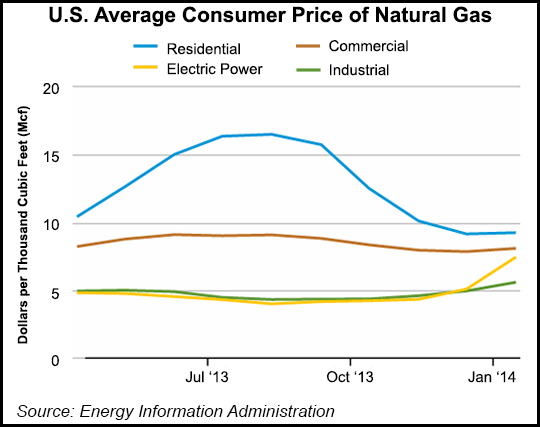Producers Lift January Gas Output to New Record as Electric Generation Gas Prices Soar
Dry natural gas production in the United States during January wasn’t slowed by freezing weather and shut-in wells, as operators again broke the record for total output with January production of 2.098 Tcf. Even with record production, winter’s chill caused a significant spike in gas prices for some segments, the U.S. Energy Information Administration (EIA) reported Monday.

The preliminary EIA-914 monthly production survey is based on reports of production and consumption rates in all 50 states. January’s output broke a record set in December, when production rose to 2.092 Tcf. Gross withdrawals in the Lower 48 increased to 2.640 Tcf, up from a revised December figure of 2.631 Tcf.
Prices for natural gas delivered to consumers in January were a mixed bag, with residential and commercial prices for the month remaining on par with recent Januarys, while gas prices for industrial and electric power generation soared, thanks to multiple brutal cold snaps this winter. Residential gas prices averaged $9.67/Mcf in January 2012, $9.17/Mcf in January 2013 and $9.24/Mcf this past January, while commercial gas prices averaged $8.06, $7.81 and $8.09, respectively.
However, industrial gas prices declined by one cent from $4.59/Mcf in January 2012 to $4.58/Mcf in January 2013, then spiked to $5.61/Mcf in January 2014. The largest increase was found in the gas for power generation segment, which averaged $3.82/Mcf during January 2012, before jumping to $4.56/Mcf in January 2013 and shooting to $7.46/Mcf in January 2014.
Lower 48 volumes for December were revised upward by 0.14 Bcf/d, mostly because of a 0.11 Bcf/d increase in gas production in Texas, which also led all of the states in January production. December totals initially had indicated that production rose 4% year/year to a high of 2.630 Tcf (see Daily GPI, March 3).
Marketed gas production climbed to to 2.215 Tcf from 2.208 Tcf in December. Net storage withdrawals for January totaled 967 Bcf, versus 714 Bcf in December. Net gas imports in January rose month/month to 161 Bcf from 156 Bcf.
Gas consumption in January was at its highest level ever at 3.219 Tcf, topping 100 Bcf/d for the first time, EIA said. Deliveries to residential (33.6 Bcf/d), commercial (18.5 Bcf/d) and industrial (23.4 Bcf/d) consumers each were the largest ever reported.
The report came as a surprise to some analysts who follow the market, particularly since there were two weeks in January that were at or below 10-year record cold temperatures.
“We would not have been surprised if production was down sequentially” on freeze-offs and pipeline shut-ins because December output had fallen 1 Bcf/d from November, said Tudor, Pickering, Holt & Co.
On a volumetric basis, Texas output was by far the most of any state, rebounding to November levels and up 0.5 Bcf/d to 22.7 Bcf/d. Gas production in Texas had fallen in December because of inclement weather. Maintenance work on Texas infrastructure was completed over the period, which was a major reason for the production rebound, according to EIA.
In New Mexico, gas output in January climbed by 2.6% from December to 3.5 Bcf/d. It had declined in December by 3.7% from November.
In the Other States category, including the Marcellus and Utica shales, output reportedly was off 0.5% from December to 28.8 Bcf/d, but that’s 20% higher than in January 2013, EIA said.
Louisiana gas production rose slightly by 0.2% from December to 5.6 Bcf/d; however, output was down more than 23% year/year (7.4 Bcf/d). Gulf of Mexico gas production continued to decline in January to 3.2 Bcf/d, versus year-ago output of 4.1 Bcf/d.
The reported production growth was significantly higher than pipeline flow estimates, which had indicated that output would fall almost 0.7 Bcf/d from December, said Barclays Capital analysts Biliana Pehlivanova and Shiyang Wang.
“Pipeline flow estimates, of course, have poor visibility into the intrastate flows in several states, most notably in Texas,” they said in a note.
Meanwhile, gas production in New Mexico increased 0.09 Bcf/d from December, while output in Oklahoma, Wyoming and Louisiana was relatively flat. Withdrawals from the Federal Offshore Gulf of Mexico declined 0.14 Bcf/d month/month.
“The year/year growth looks much higher than that of the previous month’s report (plus 1.1 Bcf/d) for 2013, as the EIA has revised the 2012 historical data lower,” said the Barclays analysts.
“While we believe freeze-offs continued to affect natural gas production in February, the February report should indicate a moderate recovery in Lower 48 gross withdrawals due to the increase of average temperatures from the previous months,” said Pehlivanova and Wang “By the end of March, production should recover completely, despite much colder-than-normal temperatures. Overall for 2014, we expect natural gas production to exhibit robust growth,” which is a forecast that several analysts have made.
© 2024 Natural Gas Intelligence. All rights reserved.
ISSN © 1532-1231 | ISSN © 2577-9877 |
